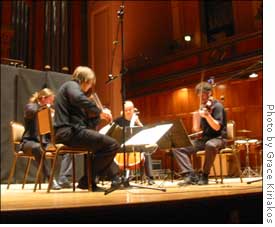| << Front page | Arts | March 19, 2004 |
Contemporary Music Ensemble fires up Finney
 |
||
| Angels in Finney: The Jasper Quartet performs amid electronic signals at the Contemporary Music Ensemble concert. | ||
The Oberlin Contemporary Music Ensemble, conducted by Timothy Weiss, presented an impressive program to a diverse and enthusiastic audience in Finney Chapel last Friday night. The most casual conservatory ensemble concert of each semester, the stage was strewn with stacked chairs, monster speakers and extraneous production materials.
Beginning the program was a piece for three musicians entitled “Trio (Vortex)” by composition professor, Lewis Nielson. The three musicians portrayed the descent into Nielson’s metaphorical whirlpool with understated emotion and impressive comfort. If for no other reason, CME concerts are worth attending simply to watch their longtime pianist, Michael Gallope, transform potentially inaccessible practically musical ideas into Mozart.
Bruno Maderna’s “Serenata No.2” (1957), written for an eleven instrument mixed ensemble, presented an extraordinarily lush depiction of musical pointillism. The ensemble boasted a keen ability to maintain the integrity of phrases with ease throughout the scattered voices. Every individual instrument succeeded in producing a beautiful individual timbre despite the difficulty of interweaving single note parts into a greater musical fabric. The effect was a persuasive serenade indeed.
David Rakowski, composer of “Imaginary Dances” (1986) wrote in his program notes, “in September of this year [“Imaginary Dances”] turns 18 and will thus be old enough to vote.” The program notes may have proven more interesting than the composition itself. More of a disclaimer than an insightful schemata, it was difficult to take the piece seriously after reading Rakowski’s excessively honest comments. The overall effect of the piece was one of scrappy yet beautiful melodic lines patched together surprisingly well by the ensemble and a great appreciation for percussionist Matthew Jenkin’s swift comprehension and concentration in his “mini-pit.”
Do not be fooled, however. Not all compositions of the 1980s suffer from self-esteem problems and quote The Next Generation theme song. Composer-in-Residence Morton Subotnick’s “A Fluttering of Wings,” written in 1986, proved to be the highlight of the evening. Performed by the Conservatory’s promising Jasper Quartet (Evan Few, J. Freivogel, Rachel Henderson and Sam Quintal), which participated in the Smithsonian Outreach Program during Winter Term, this piece was written during Subotnick’s six-year “ghost score” binge in Berlin. Subotnick’s trademark use of musical technology appears in the form of recorded high-frequency audio signals that create a “musical strobe light” effect on the amplified strings.
The Jasper Quartet demonstrated an amazing ability to communicate amid the distortion and produced a visually and emotionally evocative depiction of the work’s four parts: “A Fluttering of Wings, Dance, Halo and Song of the Angel.” A thoroughly beautiful, enjoyable and innovative piece, “A Fluttering of Wings” won the hearts of audience members, as was evident from the monstrous applause for Subotnick concluding the program.
About us
Subscriptions
Advertising
|